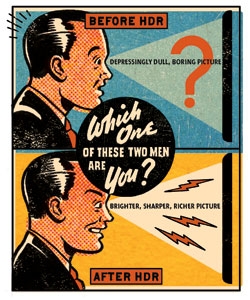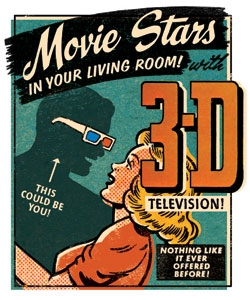5 Tech Trends for '08 Page 3
 DOLBY HDR You're probably wondering, "Dolby? But you said that all of these tech trends have to do with video." While Dolby's contributions to audio are well known - and whereas High Dynamic Range does have an audio ring to it - HDR is indeed a video technology. That role reversal demonstrates just how dramatically video dominates audio these days. In fact, Dolby was so anxious to get into the video market, and was so impressed with HDR, that it bought BrightSide, the company that originally developed the technology.
DOLBY HDR You're probably wondering, "Dolby? But you said that all of these tech trends have to do with video." While Dolby's contributions to audio are well known - and whereas High Dynamic Range does have an audio ring to it - HDR is indeed a video technology. That role reversal demonstrates just how dramatically video dominates audio these days. In fact, Dolby was so anxious to get into the video market, and was so impressed with HDR, that it bought BrightSide, the company that originally developed the technology.
HDR tackles a fundamental limitation in most TV displays: the relatively narrow range in contrast from darkness to brightness. Imagine that range in the natural world, from walking in pitch-blackness to staring at the sun - a contrast ratio that TV displays can't encompass. Manufacturers are racing to boost their ratios, and thereby improve picture realism, with brighter and darker screens and the ability to show everything in between, like the subtle luma detail that's lost in the shadows of conventional screens.
Most LCD TVs use cold cathode fluorescent lamps (CCFLs) for backlighting - which is great, but CCFLs generate a constant light across the screen that partly illuminates areas that should be black. HDR is an imaging technology that replaces CCFL backlighting with LED backlighting. A matrix of LEDs can turn different image-section backlights on and off as needed. (It's called "local dimming.") Using HDR, Dolby (BrightSide, actually) reported a contrast ratio of 200,000:1 and expects to better that. Meanwhile, Samsung, working on the same issue, has introduced screens (the LN-T81F series) with advertised contrast ratios of 500,000:1. The contest for contrast is on.
Prognosis Dolby has a good track record of bringing audio inventions to market. HDR is a slight stretch for the company, but screen manufacturers will be looking desperately for innovations that make their products stand out from the showroom-floor competition. HDR is an example of one of the many improvements that can offer that kind of demonstrable distinction. Alongside the ongoing race for increased resolution, future LCDs will also feature brightness and dynamic-range enhancement techniques like HDR.
3-D TV I know, I know - you're smirking. 3-D. It's the dorky glasses, right? Your skepticism is justified. Back in the 1950s, prognosticators thought that in the future, all movies and TV would be shown in 3-D. They said the polarizing glasses with the funky colored lenses were a small embarrassment to pay for the wonders of 3-D. They were wrong: It wasn't worth the embarrassment. Nevertheless, 3-D has been used in many films (most recently, Beowulf and U2 3D). But 3-D TV in the home? Come on.
Stereoscopic imaging strives to create a sense of depth, usually by displaying two images, one slightly different from the other. Glasses are usually required, to filter and thus determine which of the images reaches which eye. It's interesting that, living in a 3-D world, we so willingly accept so many 2-D images. But we do, and most people aren't frustrated that their TVs are lacking a dimension. Still, if you've seen 3-D, you understand its attraction, and manufacturers are actively exploring the possibilities.
 For example, Sharp offers LCD computer screens with prisms that divert light from even and odd columns of pixels to create the two images necessary for 3-D. These screens are mainly used for visualizing medical or scientific images, and although glasses aren't required, you have to sit in the center of the screen to catch the left/right views. Philips has shown WOWvx screens that similarly use prisms to divert light into nine different views, allowing a 3-D effect without glasses over a wider viewing angle. Initially, they're mainly meant for retail advertising.
For example, Sharp offers LCD computer screens with prisms that divert light from even and odd columns of pixels to create the two images necessary for 3-D. These screens are mainly used for visualizing medical or scientific images, and although glasses aren't required, you have to sit in the center of the screen to catch the left/right views. Philips has shown WOWvx screens that similarly use prisms to divert light into nine different views, allowing a 3-D effect without glasses over a wider viewing angle. Initially, they're mainly meant for retail advertising.
Closer to home, Texas Instruments has developed a version of its DLP engine that can display independent stereoscopic views. Because a true stereoscopic program requires twice the imaging bandwidth of 2-D, some 3-D systems must halve the horizontal or vertical resolution. But the DLP system is able to combine left and right images into a single frame and provides a 60-Hz frame rate to each eye for full-resolution, flicker-free presentation. Each view has a sync signal that's transmitted optically to LCD shutter glasses worn by viewers. The glasses don't need the red/blue lenses; instead, the shutters temporally admit only the correct view to each eye.
Both Mitsubishi and Samsung offer DLP 3-D-ready HDTVs at essentially the same price as 2-D screens. (You still need to buy the sync transmitter and the glasses.) The rub is that the content source must provide 3-D video. That can be sent to the TV via HDMI, but movie studios, game developers, and other content providers must step up and deliver. One more catch: There's no agreed-on 3-D standard. The 3-D movie you buy may or may not work on your 3-D TV.
Prognosis Laugh if you must, but I still think that the 1953 3-D movie Robot Monster is awesome. And I think that 3-D TV has a future. The Next Big Thing? No. But there's enough interest - and, most important, content - to fuel the 3-D business. For example, DreamWorks has said that all future animated titles will be in 3-D, making content available for the home market. And the dorky glasses? Don't worry. If Bono starts wearing them, they'll suddenly become cool.
- Log in or register to post comments



































































